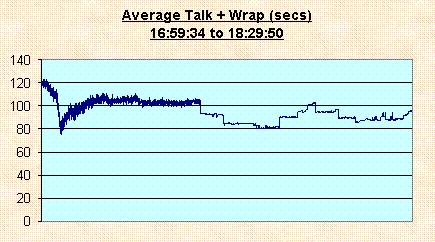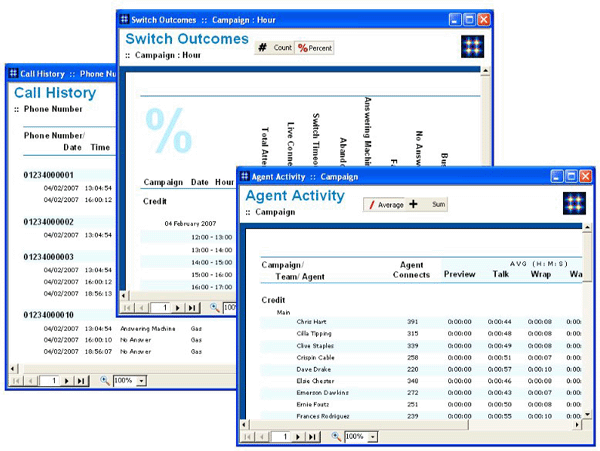The need to “manage” a dialer is unfortunately accepted as the norm within the collection industry. This applies to the managing of accounts as well as monitoring and adjusting the dialer’s performance.
 There are significant management resources that are traditionally allocated to ensuring that only certain accounts are sent to the dialer at the certain times. With the large volumes of accounts we are talking about, managing a dialer manually can be best described as a losing battle. Based on the design of RMEx, Quantrax has clearly redefined the term “integrated dialer”. RMEx’s design called for numerous “dialer-related” features as well as complete automation of collection activity with regard to the scheduling of automated phone calls and mail. Our ‘Contact Series’ allows you to define an automated series of letters and/or phone calls, allowing you to create dialer queues for new accounts. In the early-out environment this can be invaluable. RMEx’s knowledge base will allow you to set up flexible and self-adjusting work plans that will make the dialer an integral part of the collection process. You have the ability to move accounts in and out of the dialer at specific times or based on individual circumstances, without any manual effort. This will ensure timely and required effort on all of your accounts. Of course, to obtain the benefit of this technology, you must also strive to incorporate a business model that uses the “artificial intelligence-based features” of RMEx to separate the collectable accounts from those that are less likely to pay. You can then incorporate the results into well-managed, productive dialing campaigns.
There are significant management resources that are traditionally allocated to ensuring that only certain accounts are sent to the dialer at the certain times. With the large volumes of accounts we are talking about, managing a dialer manually can be best described as a losing battle. Based on the design of RMEx, Quantrax has clearly redefined the term “integrated dialer”. RMEx’s design called for numerous “dialer-related” features as well as complete automation of collection activity with regard to the scheduling of automated phone calls and mail. Our ‘Contact Series’ allows you to define an automated series of letters and/or phone calls, allowing you to create dialer queues for new accounts. In the early-out environment this can be invaluable. RMEx’s knowledge base will allow you to set up flexible and self-adjusting work plans that will make the dialer an integral part of the collection process. You have the ability to move accounts in and out of the dialer at specific times or based on individual circumstances, without any manual effort. This will ensure timely and required effort on all of your accounts. Of course, to obtain the benefit of this technology, you must also strive to incorporate a business model that uses the “artificial intelligence-based features” of RMEx to separate the collectable accounts from those that are less likely to pay. You can then incorporate the results into well-managed, productive dialing campaigns.
In addition to the managing of accounts (primarily through RMEx), I-Tel strives to produce management information in the following areas :
- Dialer production statistics. i.e. the activity of each agent, is produced by the dialer.
- Collection statistics such as promises, negative contacts etc. are reported by RMEx
- Collectors can work in a pooled environment and the dialer will report daily production statistics, while RMEx will allow you to track each account and give credit for the resulting payments to the agents who worked the account, without transferring ownership to the agent!
- The management team is able to view the collection operation’s active and current telephony configuration though special management consoles. Each dialer station is displayed along with the status of the agent and their telephone.

- With traditional dialing solutions, supervisors spend a great deal of time monitoring the dialer and tweaking dialing rates when abandoned calls increase. A well-designed dialer should allow supervisors to focus on managing their agents and campaigns, as opposed to second-guessing their dialer. This common problem does not exist with I-Tel – you define the maximum abandoned call rate (5% or less) and leave it alone! The dialer does not need a supervisor(s) to tell it how to dial, or to watch over it, waiting for it to make a mistake.
The powerful dialer-related features of RMEx combined with the reporting capabilities of the dialer will offer you several useful views of your collection operation, allowing you to better manage and utilize this most valuable resource.
Following are some details of the report server that is available within the I-Tel platform (Softdial Reporter™). These reports are independent of additional reports that may be available through RMEx.
Softdial Reporter™ is designed to bring all of the data generated by Softdial Plugin to any number of management desktops, putting critical data at the fingertips of those who need it. Users can choose from a number of pre-formatted report templates. Using the same tool, you can generate different views of campaign-related information, from statistics down to individual call detail.
As an aid to focusing on exactly the data you need, Reporter has a powerful filtering mechanism. For example, it can show
- activity from 3 days ago
- activity for Joe Smith
- calls where an answering machine was detected
- calls to phone numbers containing ‘213’
Users can draw on historical as well as current data. Any open reports can be set to update automatically as your agents work, showing you an up to the minute view of the data you choose.
Reporter can be used to
- import data and display your selected view, or
- load dialer data into a third party database, ready for enterprise-wide reporting using any standard reporting package.
Reports can be distributed with ease, by printing what is seen on the screen, or exporting to HTML, Excel or RTF format. If you would like to see when average agent activity has exceeded user-defined levels, Reporter can be set to highlight these values in red text.
Within the same report, the user can obtain answers to questions such as:
- How many calls were transferred to Agent 1?
- How long has Agent 2 spent on the phone? What is the agent’s average talk time?

The following are some of the reports that are available:
- Abandoned Call Rate (per hour)
- Agent Activity (per agent per hour)
- Agent Activity (per campaign)
- Agent Activity (per campaign per hour)
- Agent Availability (per campaign per agent per day)
- Agent Availability (per day per campaign per agent)
- Agent Call Duration (per agent)
- Agent Call Duration (per campaign)
- Agent Call Duration (per team)
- Agent Login’s (per campaign per agent per day)
- Agent Login’s (per day per campaign per agent)
- Agent Outcomes (per agent)
- Agent Outcomes (per agent per hour)
- Agent Outcomes (per campaign per team)
- Agent Outcomes (per campaign per team per hour)
- Agent Success (per hour)
- Call History (per phone number)
- Call History (per session ID)
- Campaign Metrics hour)
- Campaign Success (per hour)
- Switch Outcomes (per campaign)
- Switch Outcomes (per campaign per hour)
- Team Success (per hour)
